This was a project that grew out of my fondness for antique radios and vacuum tube technology. My goal was to build a recreation of a Thirties era radio, based loosely on the popular “Twinplex” kit. The immediate precursor to the original Twinplex receiver appeared in 1934, as a DYI construction article in a radio hobbyist’s publication called Short Wave Craft. In most respects, it was a rather unremarkable regenerative type radio (popular in the days before the ascendancy of the now ubiquitous superheterodyne) and the circuitry generally followed the standards of the day. What set it apart was the use of the then new-fangled type 19 tube, which contained two – count ‘em! – triodes in a single glass envelope. Make no mistake; this was an event as significant to the electronics enthusiasts of that period as was the advent of the first integrated circuits to their brethren a quarter century later. Hobbyists and radio amateurs were eager to try out this new technological wonder.
Front view
Of course 1934 was also the height of the Great Depression, and a lot of people ‘rolled their own’ because they simply couldn’t afford an expensive store bought receiver. Relief soon arrived in the form of a comparatively low priced radio kit produced by the Doerle Company. The kit was nearly identical to the radio featured in the article (there’s some question as to which one came first), although a few cost saving changes were made in order to appeal to a wider, cash-strapped audience. All together, the Twinplex kit and type 19 tube (sold separately) would run the prospective builder around four bucks – roughly a couple of day’s wages for the average worker. Their hard-earned money bought them a solid, no frills shortwave and AM broadcast band receiver. In the days before television and the Internet, or even passable roads in many instances, a decent radio represented a vital link to the outside world, as well as a much needed source of entertainment.
Doerle Twinplex
The Twinplex was a study in simplicity. Band selection was done via plug-in coils. A large slow-motion tuning dial dominated the front of the radio, along with the regeneration control and a filament rheostat. The open one-piece chassis sported a de rigueur black wrinkle finish. The new tube allowed for a reasonably compact layout, and while miniaturization wasn’t exactly the buzzword of the day, this compactness resulted in shorter wiring and greater operational efficiency. And though the type 19 was never intended for this kind of application (it was designed to be an audio output tube), it actually worked as well if not better than many of the more commonly used r.f. tubes. Front mounted binding posts allowed the user to hook up their antenna, ground and headphones. Battery connections were made in the rear.
I would of course be remiss if I failed to mention T. J. Lindsay’s book “How to build the Twinplex Regenerative Receiver“. He goes into far greater depth concerning the history of the Twinplex, and describes his own rendition of this radio, which is far closer to the original Doerle offering than my own. He also built a version out of a ‘modern’ tube (60/70’s technology versus 30’s) and a couple of different solid state versions. A great book if you can still find it.
Technical Stuff…
My radio generally followed the Doerle in terms of the overall layout and placement of controls, but the circuitry is an amalgamation of the Doerle, the (original?) Short Wave Craft version, and various other receivers of the period.
Mechanically, the main difference is that my receiver uses a two-piece chassis instead of a one-piece, mainly because I don’t have access to a lot of metal working equipment. Drilling, tapping and cutting; no problem. Bending an L-shaped chassis; not so much. I used a couple of industrial junction box 16-gauge (0.0598” thick) panels for the front and bottom, and a beefy L-bracket to join the two together. This made for a rather heavy receiver, but at least it stays where you put it! The parts are a mishmash of authentic and not so authentic parts from various eras. I tried to stay as close to the Thirties as I could, but that wasn’t always easy. The main tuning capacitor was salvaged from a pile of free junk at a hamfest. Some of the plates were literally welded together, as if they’d been shorted across line voltage, and the thing wouldn’t even turn. Since I didn’t need that much capacity anyway, I just yanked out the bad plates with some pliers and my capacitor was ready for action again.
Electrically, the Twinplex is basically just an Armstrong regenerative detector followed by single stage of audio. The design is little different than countless other two-tube sets from that era. The most obvious difference between my rendition and the original is the inclusion of a 3:1 interstage transformer, used to match the relatively low impedance output of the detector stage to the high impedance input of the audio stage. The Short Wave Craft version and the Doerle kit both used RC coupling between the stages (not as efficient perhaps, but a whole lot cheaper). Since the transformer provides a noticeable increase in volume, I added a volume control as well. I reintroduced the grid bias on the audio stage (R4 and C7), found in the Short Wave Craft version but eliminated in the Doerle as another cost savings measure. This grid bias is used to improve fidelity. Capacitor C6 provides some high frequency roll-off. The smallish knob on the upper left hand corner is the antenna trim. The Doerle had one as well, but in that setup was adjusted by screwdriver via a small hole on the front of the radio.
Design Tradeoffs, goofs, etc…
I personally find these kinds of discussions far more fruitful then dry dissertations along the lines of ‘hook wire ‘A’ to terminal ‘C’ and voilà! A radio is born!’. People love to talk about what went right, but very seldom talk about what went wrong, or things they might have done differently. And while I learn a great deal from my own mistakes, I much prefer to learn from other people’s mistakes. Maybe you can learn from mine.
The first tradeoff isn’t really an issue from my perspective, but it might be for someone else. In both the Short Wave Craft article and the Doerle kit, the filament rheostat has a value of 20 ohms. Now given that we’re dealing with a two volt tube filament drawing about 0.26 amps, 20 ohms works out pretty well, assuming your “A” (filament) battery is six volts. It wasn’t uncommon back in the day to pull the battery out of the jalopy (commonly six volts at the time) and use it for the radio. Alternately, I could see someone using a six volt lantern battery to do the same thing.
In my version, I used a 10 ohm rheostat, because that’s all I could find at my local surplus electronic warehouse. Since I’m powering my radio from a custom built small tube radio supply anyway, all I do is set the filament voltage selector to “2 volts” and crank the radio’s filament rheostat all the way up, meaning the rheostat is mostly just decorative. Regardless of what you decide to do, just make sure you don’t put more than two volts on the filament. You’ll either shorten the lifespan of the tube considerably, or burn it out altogether. As an aside, as the type 19 has a directly heated cathode, you MUST use pure DC on the filament. I mention that only because a lot of experimenters have probably never encountered a directly heated cathode before.
The next issue was mechanical. The Twinplex kit was laid out very nicely overall, but there was clearly never any intention of slapping an interstage transformer on the chassis. I really wasn’t happy with the way I had to route wiring and components around to accommodate it. If I had it to do all over again, I would have spent far more time noodling out how everything was going to ‘flow’. In fact, I might have elected to avoid using the transformer altogether. Lindsay is a big proponent of prototyping a project ahead of time, so you can make all your mistakes and corrections on the prototype, as opposed to doing it on the finished product. Sage advice, assuming I can ever force myself to do it. Incidentally, a lot of the later Twinplex-esque construction articles of the period used interstage transformers, although I don’t know of anyone who tried it on a Doerle style chassis.
Rear view
The biggest problem on this radio is the regeneration control. On both the Short Wave Craft version and the Doerle kit, the regeneration control basically consists of a potentiometer wired across the “B” supply, serving as an adjustable voltage divider supplying the detector portion of the tube. This is a fairly foolproof way of doing things, at least insofar as a triode is concerned. The only problem with this method is that it represents a constant (albeit small) load on the “B” supply, even when the radio is turned off. Due to a self-imposed desire to shut the radio off completely with the SPST switch mounted on the aforementioned filament rheostat, I couldn’t go with a voltage divider, because I simply couldn’t figure out a way to kill everything with one switch. So what I did instead was wire a potentiometer in series with the B+ for the detector, allowing me to vary the current flowing through it. This is a far less desirable method.
There are several possible resolutions. One would be to use a throttling capacitor to control regeneration. I’ve not tried this system personally, but it’s been my observation that people either seem to love it or hate it. Everyone generally agrees that it provides smooth, repeatable control. The problem is that it also shifts the operating frequency, as you’re essentially coupling another variable reactance to the tank circuit. To what degree this would occur and to what degree it would be bothersome is a matter of conjecture here, but on a more practical note, my regen control is really on the ‘wrong’ side to employ this method, as I would want the cap as close to the coil as possible. Were one to build a Twinplex with a throttling capacitor, they’d do well to swap the positions of the regeneration and filament controls on the front panel, or perhaps swap the positions of the tube and the coil on the rear. Such an exercise would certainly make a great case for Lindsay’s prototyping technique.
Another would be to swap out the existing SPST switch on the rheostat with a DPST switch. Then it would be a simple matter to disconnect the “A” and “B” supplies simultaneously and still retain the original Twinplex regeneration voltage divider pot. The only problem here would be finding the right toggle switch that will work with the existing mechanism on my rheostat. Probably not very likely unless I get really, really lucky.
Easier still would be to disregard the switch altogether and simply disconnect both batteries or shut off the power supply when the radio’s not in use. Otherwise known as the KISS method.
In all honesty it’s unlikely that I’ll select any of these options, as I’m loath to go back and work on ‘finished’ projects, even when it could be reasonably argued that they’re not entirely finished. Constructing the Twinplex was an enjoyable experience in its own right, but I’m always too busy planning the next three of four projects ahead. If I were to revisit the Twinplex, it would likely be in the form of a more modern rendition. I might even consider building one from a 12Vdc ‘space charge’ automotive tube (some interesting history there as well), as I’ve had quite good luck with those. It would certainly be a far easier prospect with all of the ‘antiquing’ considerations done away with.
Schematic (my version)
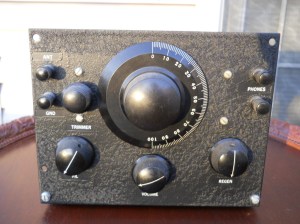
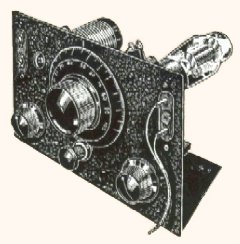
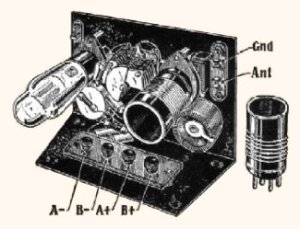
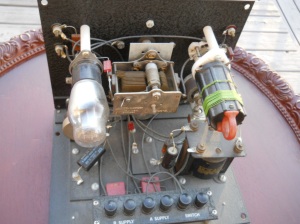
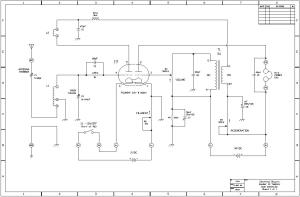
The Twinplex was not designed by Doerle and Doerle never sold kits. J.A. Worcester, Jr designed the original Twinplex and unofficial kits of Walter Doerle’s two tube regen and a version of Worcester’s one tube radio were sold by Radio Trading Company. The bent chassis version was designed by their Chief Radio Engineer N.H. Lessem and he called it the “Unimount Twinplex” and was designed to be as cheap as possible ($15 vs $4.95).
Greenpark Company claimed to have the official Doerle radios. They also sold the Twinplex and another of Worcester’s designs – The Oscillodyne.
Well, a couple of comments. First, neither T.J Lindsay or myself ever suggested that the Twinplex was actually designed by Walter Doerle – merely that it was marketed by Doerle’s company. The 1935 article “The “19” TWINPLEX Makes 1-Tube Perform as 2” was indeed penned by J.A. Worcester, although it remains unclear whether he was in fact the original designer. Worcster himself made reference to, “…the “53” Twinplex receiver described in the October issue of this magazine” but says nothing else regarding that earlier article. Given the sensibilities of the day, I’ll assume that he wrote the earlier article as well, given that he didn’t cite another author. Lindsay wrote that the Twinplex proper originally appeared in Gernsback’s Shortwave Craft magazine in 1934. The reprint of the 1935 Shortwave Radio Manual appears to be a compendium of articles from around that time period, so it’s entirely possible that Worcester article(s) did indeed appear in late 1934. Sadly, I don’t have access to the original magazines, so I can’t say with certainty one way or the other. Regardless, I believe the basic concept was ‘in the air’ so to speak almost as soon as the “19” appeared. I don’t know if there’s any way to definitively say that Worcester ‘invented’ it. I think it’s certainly fair to say that his article(s) did much to help popularize the design.
As an aside, Lindsay claimed that a precursor to the Twinplex – still based on the “19” tube – first appeared in 1933. Unfortunately he says little more about it.
Lindsay states that, “A few months later the Doerle company was advertising a kit version of the radio.” (page 9 of “How to build the Twinplex Regenerative Receiver”) I can’t think of any way to interpret this other than how it’s written. Lindsay could be mistaken here, although he seems to have done his research. Having said that, the illustration (also on page 9) shows a Twinplex kit marketed by the Radio Trading Company of New York. No mention is made of Doerle. However the following page shows another advertisement for a Twinplex kit (from the Oscar B Kusterman catalog) which is called, “The Doerle “19” Twinplex Receiver”. Confusion abounds! Neither ad shows a price anywhere near $15, and that seems awfully steep given the economics of the day. I’ll have to stand by my “around four bucks” price, as that’s essentially what’s shown in the Kusterman ad ($3.50 if we’re going to be exact). Perhaps the $15 reflects the cost of a pre-assembled Twinplex versus the kit version?
The Twinplex aside, Worcester was a fascinating individual and a prolific contributor to Gernsback’s periodical. I’ve long been intrigued by his ‘Oscillodyne’ you brought up, which he claimed differed from the similar super-regenerative of the era. And while there’s little reason to unleash such rancorous beast on present day shortwave bands, it would be fun to try one all the same. Or perhaps create a switchable Oscillodyne/Super-regenerative version to allow a direct head to head comparison between the two.